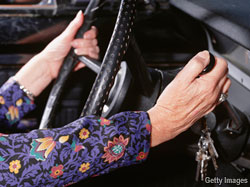
(ARA) – The decision on when an aging loved one should stop driving is never an easy one, but the issue becomes even more complex – and heart-wrenching – when the loved one also suffers from dementia or Alzheimer’s disease. How do you know when someone is no longer safe to drive? How do you gently explain this to him? How do you take away her car keys without taking her dignity as well?
“While some people with dementia can still drive safely for a time, nearly all people with dementia will eventually have to give up driving,” says Dr. Donald J. Iverson, with the Humboldt Neurological Medical Group, Inc. in Eureka, Calif., and Fellow of the American Academy of Neurology (AAN). “It’s important for doctors to discuss this with patients and caregivers soon after the diagnosis since driving cessation may affect the patient’s and caregiver’s quality of life.”
AAN recently issued guidelines, presented at its Annual Meeting in Toronto on April 12, to help caregivers and doctors determine when people with Alzheimer’s disease and other forms of dementia should stop driving.
Caregivers should trust their observations of unsafe driving when deciding if a loved one is no longer safe behind the wheel, the guidelines advise. Caregivers who rated a patient’s driving as “marginal” or “unsafe” were often proven right when the patient was given an on-road driving test, the AAN’s research found. However, patients who thought their driving was safe were not necessarily right in their own assessments.
“While patients with mild dementia, as a group, are higher-risk drivers, more recent studies have shown that as many as 76 percent can still pass an on-road driving test and can safely drive,” Iverson says. “We need to provide guidelines for caregivers and doctors caring for these patients to identify those at higher risk of unsafe driving, without unnecessarily restricting those who are safe drivers.”
If you’re acting as caregiver for a loved one with dementia symptoms, watch for signs of declining driving ability, the AAN guidelines advise. These may include:
* Accidents or tickets.
* Aggressive or impulsive behavior.
* Decreased miles being driven.
* Always avoiding certain driving situations, such as driving at night or in the rain.
While the observations of caregivers who know the habits and skills of their loved one are instrumental in determining if someone is no longer safe to drive, a number of tests can help identify the risk as well. These include the Clinical Dementia Rating (CDR) scale, which measures brain functions such as memory, judgment and problem-solving. The Mini-Mental State Examination (MMSE) also measures brain functions such as memory, language and spatial ability. While these tests may help to show if a person has dementia and the severity of the disease, alone they’re probably not enough to determine if someone is unsafe to drive. Caregivers and doctors need to make the final assessment.
When patients receive diagnoses of dementia, they and their caregivers should begin talking to their doctor about the eventual need to stop driving. That way, when the time comes, the conversation will be a little bit easier, the AAN suggests.
Patients, caregivers and doctors should also research their state’s laws, since some states require doctors to report medical conditions that may impact an individual’s ability to drive safely.
“It is important that the decision to stop driving be directed by a doctor who is trained and experienced in working with people with dementia and their families,” Iverson says. “Doctors should be aware that assessing driving ability is a complex process. More than one source of information is needed to make a judgment. In some situations, a dementia specialist may be needed.”
To learn more about the guidelines and the American Academy of Neurology or to find a neurologist near you, visit their Web site at www.aan.com.
Courtesy of ARAcontent





